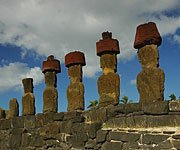 The deforestation led to erosion and the decline of agriculture, the carrying capacity of the island was surpassed and it all ended in a cannibalistic civil war with resultant population collapse about AD 1650. This story has been most recently been told popularly in Jared Diamond's best-selling book Collapse.
The deforestation led to erosion and the decline of agriculture, the carrying capacity of the island was surpassed and it all ended in a cannibalistic civil war with resultant population collapse about AD 1650. This story has been most recently been told popularly in Jared Diamond's best-selling book Collapse.
But an archaeologist from the University of Hawaii has just presented a paper that challenges all of this. He believes the culprit for deforestation was a human-induced species of rat that did the work prior to substantial human settlement. The radiocarbon dates and pollen data seem to hang together with this scenario. Additionally, he really can't find much of any evidence of warfare in the archaeological record. If I remember my long-ago readings of Thor Heyerdahl correctly, the war and cannibalism was based on an Easter Island native folk-tale.
This ought to be another of those archaeological controversies that will be fun to watch.
No comments:
Post a Comment